By Ken Perrotte – for The Hunting Wire
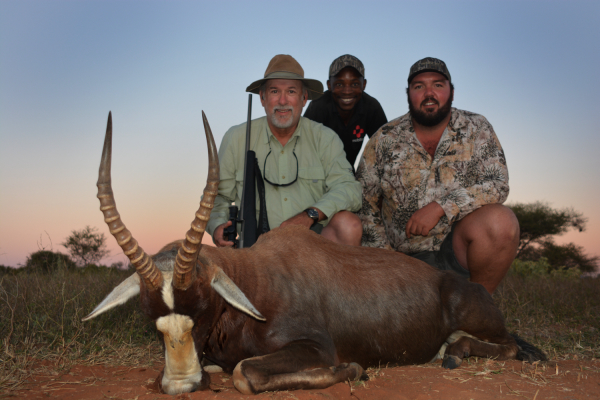
We were minutes from calling it a day - a long, warm day – and slowly traveling a final stretch of sandy road leading toward the sprawling ranch’s gate when the reclusive bull sable finally decided to betray his hiding place. We immediately knew it was him. The top of a sable’s nose is usually a jet-black strip. This old bull had a prominent white patch centered on that strip.
The old bull sized us up for a few seconds before moving from the thicket, giving us a going-away view of his dark rump and horn tips.
With Professional Hunter Pieter Taylor and our South African tracker Juscias, we grabbed my Mossberg Patriot rifle and shooting sticks and moved briskly about 100 yards left of the direction the animal was headed. We paralleled his likely track, hustling to intercept him.
Taylor set the sticks as we reached the edge of a sandy trail in the expansive bushveld just as the bull appeared 60 yards away. I quickly positioned the rifle, taking a solid broadside shot within seconds. The 300-grain Hornady DGX rounds loaded in the .375 Ruger gun – I had been hunting cape buffalo most of the day – instantly felled the ancient bull.
While a buffalo was the top objective during a late June 10-day safari to South Africa’s Limpopo Province, a stately sable was a close second. South Africa’s sables are mainly found in Limpopo, which abuts Botswana and Zimbabwe.
Sables are currently listed as a species of “least concern,” meaning populations are stable or even growing but antihunting groups still take aim at hunters opting to pursue this antelope species. It is relatively common today to see outfitters offering special package hunts for both buffalo and sable.
Bronkhorst shared that early farmers used to shoot sables to provide meat for farmhands. Sables like to settle near water, in well-drained areas that offer good grazing opportunities. This is the same type of land valued by people for agriculture and raising livestock. Conflicts must have been inevitable, at least until sables derived enhanced value as a huntable species.
Our mornings and early afternoons focused on the buffalo quest, but miles of tracking had yet to offer a shot, despite a couple close calls, including one where we found ourselves just 30 yards from a small bachelor herd. A young bull presented the only shot opportunity. Taylor wisely recommended passing.
Old Bulls, Young Bulls
Taylor and our videographer Ruan Geyser, also a certified professional hunter, had previously hunted this huge property about an hour from outfitter Phillip Bronkhorst’s Bateleur Safari Lodge [www.pbsafaris.com] several times. They knew a little about this particular old bull sable.
We encountered a couple groups of sable during the early morning exploration for fresh buffalo sign. The first was a large herd in a meadow. Some animals fed while others bedded near shade trees. Most were females with calves although one nice herd bull lounged nearby. The second was a bachelor pair, with one looking pretty darn nice to me.
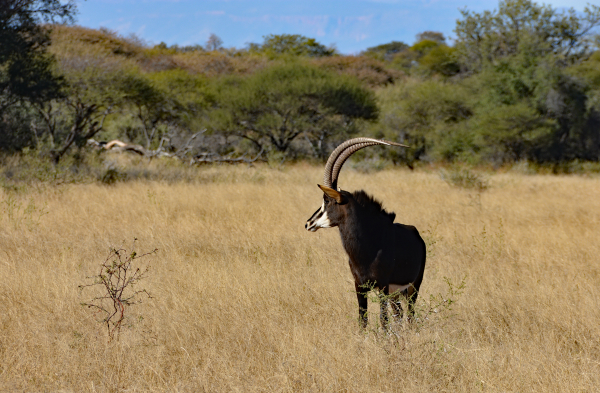
“That’s still a young bull, sir,” Taylor admonished, pointing out the animal sported reddish-brown coloring in his darkening coat. Fully mature bull sable have a coat with a striking black sheen. While the younger bull looked good to my inexperienced eyes, Taylor was determined to find the old bull.
The white patch on the nose, estimated to be a worn spot from years of rubbing or fighting, made the bull conspicuous. That and the fact he was now an elderly outcast booted from the herd after serving as that territory’s leader for years. Doubtlessly, many of the young sable there were his offspring.
“This bull has to be, at least, 12 to 14 years old,” Taylor said.
Africa has dozens of antelope species. They belong to the Bovidae family, along with goats, sheep and buffalos. Many consider the sable the apex antelope, a barrel-chested, long-maned, elegantly marked creature with remarkable ringed horns that rise vertically and curve backward. Calves are reddish-brown at birth, eventually developing an adult’s white markings. Adult females and younger males can have coats ranging from a vibrant chestnut brown to brownish black.
The scientific name of the Sable Antelope, Hippotragus, blends two Greek words, "hippo"-meaning "horse-like" and "tragus"-meaning "goat." Unlike American deer, which are mostly crepuscular – most active around daybreak and dusk - sables are diurnal and most active in daylight. Still, the warm South African afternoons, even in winter, saw most animals bedded.
A Miss, Somehow
We encountered the old sable late in the afternoon on our first day of hunting. Pursuing on foot, we pushed him to the edge of the large meadow where he stopped and gazed back into the bushveld.
“Range – 130 yards,” Taylor said, a distance not among my preferred options. The rifle was topped with a GPO 1-6x24 scope with an illuminated reticle. Dialed up to the highest setting, the sight picture at 130 yards somewhat resembled that of a nice whitetail at 100 yards.
As I contemplated shooting, a small herd of impala raced by, negating that notion. The sable burst forward with them. We moved quickly to the left. The animals had stopped after a 100-yard gallop. Slightly out of breath, I again rested the gun on the sticks, found the sable and flipped the safety into the “fire” position.”
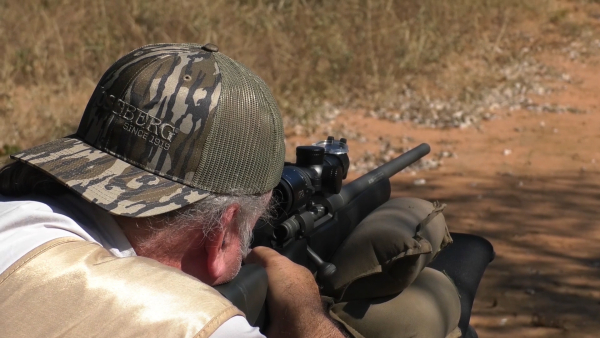
Just as I was squeezing the Mossberg’s trigger, the impala, now joined by an ostrich, began running again. My eyes impulsively darted to the moving animals, and I jerked the shot right, immediately knowing I had botched it. But I believed – prayed - it was a clean miss since a puff of dust kicked up beyond the sable.
Any shot on a safari results in a thorough search to ensure a perceived miss was, in fact, a clean miss. The sable ran hundreds of yards without faltering, but we still went to the spot where it disappeared, scouring the ground for any sign of a hit. Fortunately, all was clear.
When we couldn’t find the old sable in late afternoon of the second day, I silently worried something was amiss. On day three, there he was again.
The final shot happened within minutes of a breathtaking South African sunset. Approaching the aged bull, I was stunned by its size, easily more than 500 pounds. Beyond that, up close I could see battle scars on its face and thick 43-inch horns. The usually deep-black mane had about as much gray hair as my own beard. I gave thanks to the animal, pondering the years it ruled in the bushveld and how it was well into the denouement of a long life.
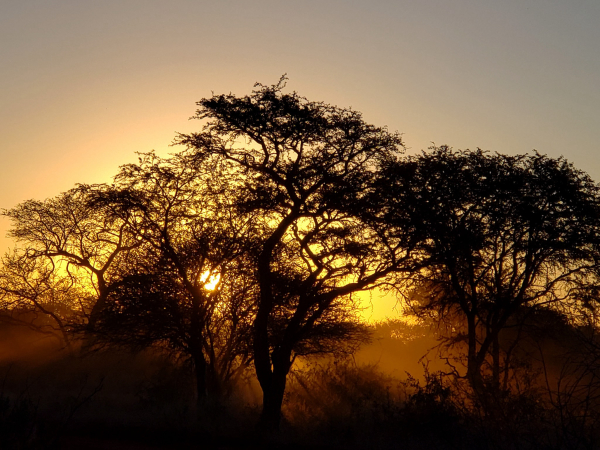
Two ‘Boks Round It Out
Blesbok and gemsbok are herd species that thrive in grassland habitats of South Africa and neighboring countries. They are often among the first plains game species taken by hunting newcomers to South Africa. My earlier trip in 2015, again hunting with Bronkhorst and a very-young Pieter Taylor, fresh from a stint as a pro rugby player, saw me take a terrific southern greater kudu, a blue wildebeest and a large impala ram.
“Welcome to the 50-inch club, sir,” Taylor had said, extending his hand to share that my kudu wore 53-inch horns.
Cape buffalo and sable were my 2021 priorities, with the blesbok and gemsbok optional if time permitted.
Candidly, getting either likely wasn’t going to entail much heavy lifting. Both species abound on the ranches we hunted. The key was getting close enough to the herd to evaluate individual animals and then take a clean shot that wouldn’t endanger other animals nearby.
I brought four different types of Hornady ammunition for the safari. The 300-grain DGX (Dangerous Game eXpander) and 300-grain DGS (Dangerous Game Solid) were the primary cape buffalo rounds. The DGX cartridges were in the rifle when I took the sable. For the blesbok, I downsized, using a 250-grain GMX cartridge for the blesbok. I loaded 270-grain SP-RP (spire point, recoil proof) Superperformance rounds for the gemsbok.
One happy surprise was that each of the four different cartridges grouped within a couple inches of each other at the range, meaning re-zeroing wasn’t needed if I wanted to switch things up. Still, my goal was to try to keep all shots close to 100 yards or nearer since I hadn’t verified performance at longer ranges.
Taylor glassed the herd of about 30 blesbok, looking for an older bull. Besides slight variations in body size, horn length and coloration reveal the more mature animals. Taylor said he looks for light-colored rings on the horns, a sign the animal has some age.
I’ve never been much on keeping up with trophy scores and record book entries but know that they serve as benchmarks for making sure animals taken are mature representatives of a species. I was advised by Oregonian Harold Miller, a frequent Africa hunter who was in camp, that any blesbok with horns 15 or 16 inches long is considered an exceptionally good bull. Miller had taken an incredible 19.5-inch blesbok bull a couple days earlier in South Africa’s Free State province.
We chased around this blesbok herd earlier in the hunt without taking a shot. Taylor soon identified two old bulls, both of which seemed intent on bullying younger herd members nearby. The vaguely larger of the two, the one with a coat slightly darker in coloration, died instantly with a shot to the lower neck at 110 yards. He turned out to have 17-inch horns, a big, mature animal.

The gemsbok quest saw us return to the large ranch where we hunted buffalo and sable. The place was well-populated with both gemsbok and impala. Female gemsbok have longer horns than male gemsbok and in some places they are fair game. Most of the females here, though, were obviously pregnant, their bellies sagging toward the ground. We began looking for a mature male.
My safari was in its next-to-last day. The abundant wildlife where we were hunting had me thinking as much about photography as getting a gemsbok. When a respectable old bull offered a chip shot shortly after daybreak, I passed, telling Taylor we could return to that location later after we had ridden around and took advantage of early morning light for photography. Plus, mornings had been warming quickly. I silently worried that taking an animal too early might necessitate an early departure – one before I had a chance to shoot photos.
We later followed a pair of gemsbok into the bushveld and actually got on the sticks, considering a shot before Taylor called it a “no go.”
Naturally, the intended bull was nowhere to be found around 10 a.m. when we looked again. We staked out the edge of a large field, catching glimpses of several gemsbok maneuvering through thick cover at the edge. Steadily, they moved into the open, revealing a herd of about 40 animals of all sizes.
This time, Taylor identified a shooter bull 100 yards away. I dialed the scope to 6 power. The main challenge was waiting patiently for a pregnant female to step forward and clear the shot window. As soon as she did, I squeezed the trigger making a perfect shot on the sharply quartering away gemsbok bull.
My South African hunting odyssey was over.
I don’t know when, or if, I’ll ever trek there again. The mounts from this trip eventually will grace my home. I can’t perfectly explain why, but those mounts become time machines. Looking at them magically transports me back to that day, summoning memories of the people I was with and the smells and sounds of the hunt. They honor the animal, the experience and the traditions.
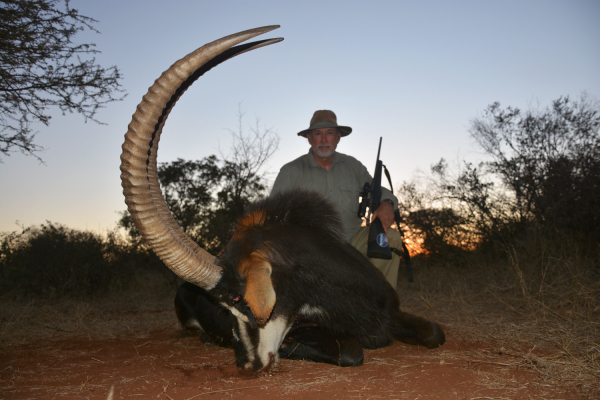
Next: Some tastes of Africa, courtesy of the game animals harvested, including an incredible buffalo tail soup. For more images and a video of the plains game and buffalo hunts, visit www.outdoorsrambler.com.